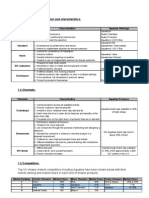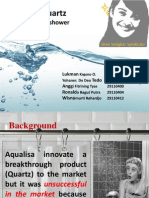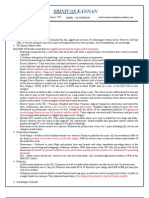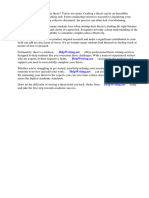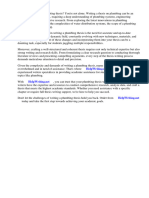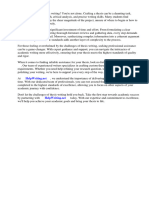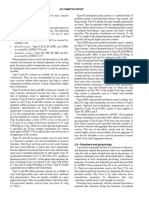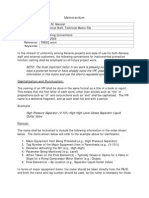Trays PDF
Trays PDF
Uploaded by
Bilal HasanCopyright:
Available Formats
Trays PDF
Trays PDF
Uploaded by
Bilal HasanOriginal Title
Copyright
Available Formats
Share this document
Did you find this document useful?
Is this content inappropriate?
Copyright:
Available Formats
Trays PDF
Trays PDF
Uploaded by
Bilal HasanCopyright:
Available Formats
Generic Industry Guides
Welcome to the Shower Trays Generic Industry Guide one in a series of Industry Guides which are available free from the Bathroom Academy website www.bathroom-academy.co.uk
We believe you will find the contents of the guides both informative and relevant and hope you will consider them a valuable aid to your continuing professional development and that of your colleagues, within the Bathroom Industry.
This guide is one in a series of guides. Other guides in the series include:
Baths Bathroom Furniture Brassware Domestic Water Systems Sanitaryware & Fittings Shower Controls Shower Enclosures Thermostatic Mixing Valves
New Guides on the way include:
Boilers Inclusive Design Wetrooms Each guide has been written by experts and Right Choice of Product for End User Needs Generic Industry Design Generic Industry Installation Frequently Asked Questions Generic Industry Terminology The Shower Trays Generic Industry Guide looks at the vast range of Shower Trays that are available and offers essential information which will allow the merchant, retailer and installer to sell and install the right Shower Tray for the end users needs. Whilst the customer's major considerations will be cost, image and performance, consideration of building infrastructure, total water systems together with location will ensure that the most suitable trays are installed giving maximum performance. Electrics in Bathrooms All will be downloadable free of charge from www.bathroom-academy.co.uk How to gain evidence and recognition of your knowledge of the Shower Trays. Did you know that when you have studied the guide in detail you can apply to be assessed and tested on your new found knowledge and if successful, achieve the Shower Trays Bathroom Academy Merit? To find out more about what you need to do to achieve this qualification go to www.bathroom-academy.co.uk/courses.asp
Industry Guide to Trays (Issue 3/11) Copyright 2011 Bathroom Manufacturers Association
Generic Industry Guides
Get qualified
You can obtain valuable qualifications as proof of your knowledge and skills by completing additional components relating to this Guide and others in the series.
Customer Service
Customers are becoming more demanding and expect much higher levels of customer service and product knowledge than they have ever done in the past. Having the right product knowledge and using it effectively and with confidence creates loyal customers who will come back time and time again. It also helps you to answer questions and solve problems, creating a good impression of the company, whether you deal with your customers by telephone, email or face-to-face.
Bathroom Academy Merits
To achieve 1 Merit, you must 1 Read the Guide 2 Complete an on-line workbook 3 Complete a timed questions and answers test 4 Write a short scenario describing how you have used your knowledge when dealing with customers. This will give you 1 Bathroom Academy merit, for which you will receive a certificate.
Retail Skills
Retail is one of the fastest growing sectors in the UK economy. Customers are no longer satisfied with average service. In a highly competitive market, they look for those showrooms, shops and people who are the most professional to deal withand excellent product knowledge, used well, means that customers will come back to you. Nationally recognised qualifications, examinations and assessments are regulated in England and Wales by OfQual: http://www.ofqual.gov.uk/ For more information about the Qualifications and Credit Framework, click here:http://www.qcda.gov.uk/qualifications/60.aspx
Certificate in Bathroom Studies
Completion of 6 Merits on the subjects of your choice will earn you your Certificate in Bathroom Studies.
NVQ Diploma
Your completed Bathroom Academy Merits can be put forward as evidence for a nationally recognised qualification. Previously known as NVQs, the new QCF (Qualifications and Credit Framework) qualifications are tailored to the needs of the Bathroom sector. The NVQ Diploma is based on achieving a certain number of Credits (each Bathroom Academy Merit will have a QCF 'Credit Value'). By completing the Certificate in Bathroom Studies and collecting further evidence of, (for example), dealing with customers, working safely, solving problems and so on, you can achieve an NVQ Diploma. This will prove your competence in your customer service role and / or retail skills in the Showroom. Your NVQ Diploma evidence will come from what you do at work, so there is no need to attend classes or do exams. You are assessed by a friendly, qualified assessor who visits you at work, observes you dealing with customers and asks you questions relating to your work. All your evidence is kept and assessed securely on-line, so there is no need for bulky files of paperwork.
Contacts
For more information about Bathroom Academy Merits and the Certificate in Bathroom Studies, please contact:Bathroom Manufacturers Association Innovation Centre 1, Keele Science & Business Park, Newcastle Under Lyme ST5 5NB Telephone: 01782 631619 email: info@bathroom-association.org.uk Website: www.bathroom-association.org For more information about nationally recognised QCF Bathroom qualifications in Customer Service and Retail Skills, please contact:Keith Marsh Axia Solutions Limited Unit 1, Riverside 2, Campbell Road, Stoke-on-Trent, ST4 4RJ Telephone: 01782 572777 email keithm@axia-solutions.com Website: www.axia-solutions.co.uk
Contents
Introduction Section 1 Features of Different Shower Trays - Standard Shower Trays - Low Level Shower Trays - Shower Trays with Upstands - Riser Shower Trays Section 2 Materials - Moulded Acrylic with Glass Reinforced Plastic - Solid Surface - Steel Enamel - Stone Resin & Acrylic Capped Stone Resin - Fireclay Section 3 Installation - Non-Riser (Wooden Floor Installation) - Riser (Solid Floor Installation) - Finish the Installation - Basic Panel Installation Procedure - Upon Completion - User Maintenance - Low Level/Level Access - Installation Procedure Direct to the Floor - Installation Procedure Direct to the Joists - Important Notes about Installation Procedures Section 4 Frequently Asked Questions Section 5 Industry Terminology Section 6 References Section 7 Useful Sources of Information Water Efficiency
4 5 5 5 5 5
6 6 6 7 7 7
8 8 9 9 10 10 10 11 11 11 12
13
14
15
16 17
Introduction
Shower Trays, irrespective of the material they are made from, are available in a substantial range of shapes and sizes. There are traditionally six standard shapes seen below.
Square
Rectangle
Quadrant
Offset Quadrant
Pentangle
Offset Pentangle
Section 1 Features of Different Shower Trays
Shower Trays can be classified by their unique features.
Low Level Shower Trays
Low level shower trays are approximately 50mm in height. Differing types of material are used to make low level trays. Some are made using Solid Surface technology whilst others are made from either Stone Resin or Acrylic capped stone resin. This means that they are extremely strong.
Standard Shower Trays
The diagram shows an example of a standard height shower tray. This type of shower tray, usually made in stone resin (either with an Acrylic or gel coat surface) allows for ease of access. The stone resin does not require legs or a base board. Owing to its inherent strength it can sit directly onto a floor, supporting the weight of the person showering.
Some manufacturers recommend that they be fitted to a flat wooden or concrete floor. However, in all cases installers must be careful to follow the installation instructions provided by the manufacturer of the tray. These trays can simulate the wetroom look and can eliminate any step into the shower.
Riser Shower Trays
Shower Trays with Upstands
The photograph below shows a shower tray with an upstand. This type of shower tray is usually made from stone resin or acrylic material. This allows for an effective seal between the shower tray and the bathroom wall. The shower tray with an upstand may or may not require feet or a baseboard. This need for feet and baseboard depends on the shower tray material. Acrylic shower trays generally need feet and baseboards.
This shows a shower tray with adjustable feet or risers. A set of adjustable legs is added to enable pipe work to be fitted above floor level. Risers allow for levelling on uneven floors. Riser shower trays are available with and without up stands. This type of shower tray is generally made from Acrylic or Stone Resin and will be supplied with matching panels.
Section 2 Materials
There are 5 main types of materials used in the construction of Shower Trays.
Moulded acrylic or Acrylic capped ABS with glass reinforced plastic Stone Resin & Acrylic capped Stone Resin Solid Surface Steel Enamel Fireclay
Adjustable Legs The diagram shows a typical acrylic shower tray with its baseboard and adjustable feet. The baseboard is a reinforcement and the adjustable feet compensate for uneven floors and to allow for height adjustment.
Solid Surface Shower Trays Moulded acrylic or Acrylic capped ABS with glass reinforced plastic
The advantages and features of moulded Acrylic trays are: Warm to the touch Extremely durable Lightweight Designed for domestic use Easily transported Easy to install Easily located and installed Available at the higher end of the price range Available in a wide range of colours Resistant to staining Hardwearing Suitable for domestic use Excellent resistance to water staining Available throughout the price range Upstand options available Construction These shower trays are manufactured from a range of Acrylic and Acrylic capped ABS sheets and reinforced for strength and rigidity. Generally reinforcement is provided by spraying glass reinforced plastic (GRP) to the underside. The shower trays are manufactured from a range of acrylic sheets having different thicknesses typically 3mm 5mm or 8mm thick. As a rule the greater the thickness the less GRP reinforcement is needed on the underside. Solid surface technology means that a liquid mix is poured into a mould, set and then released and the shower tray material is therefore consistent throughout. This gives a shower tray of great strength which then needs no additional reinforcement as the minimum wall thickness of the material is likely to be 10mm or 12mm. Construction Consequently they can then be installed directly onto wooden or concrete floors - when tiles or carpet is then laid up to the tray, the step into the shower has been eliminated as the tray will be only of 50mm height in total. Advantages and features of Solid Surface trays are: Low Level/Level Access Warm to the touch
Section 2 Materials
Steel Enamel Shower Trays
Advantages and features of Steel Enamel trays are: Abrasion resistant Impact resistant Heat resistant Low expansion levels with temperature change Easily repaired Resistant to staining Construction Only special alloy steels with low carbon content suitable for enamelling are used. The tray shells are pressed then sprayed with a special enamel ground coat to ensure good chemical bonding with the metal and subsequent finish coat. The finish coat is sprayed ensuring a very even finish. The trays are then fired through a furnace at temperatures of 850C to produce a glass hard permanent lustrous life time finish with chemical and scratch resistance second to none.
Construction A surface of a sprayed polyester gel coat or moulded acrylic or acrylic capped ABS sheet is placed in the mould. A polyester stone and resin mix is cast onto this surface to form a complete tray. This sets to form a strong durable product. Leg sets can be fitted to accommodate plumbing that is above floor level if required.
Fireclay
Advantages and features of these trays are: Available in a wide range of colour sizes and prices Higher end of the price range Easy to clean Resistant to staining Heavier than Acrylic Long lasting Fade proof Resistant to acids and alkalis Suitable for domestic use Construction The traditional method is to pour slip into a plaster mould. Slip is made by mixing together water, various clays and minerals. The plaster of the mould absorbs the water from the slip leaving a firm clay piece. This is then carefully removed from the mould and trimmed and smoothed {fettled}. The mould is dried and reused. The clay piece is dried in a warm air dryer and then sprayed with glaze. The piece is fired after spraying in a kiln where temperatures exceed 1200C. This results in a strong ceramic product with a surface impervious to acids and alkalis. Fireclay shower trays are not fitted with adjustable legs.
Stone Resin and Acrylic Capped Stone Resin Shower Trays
Advantages and features of these trays are: Available in a wide range of colours and shapes Available throughout the price range Very strong Hardwearing Heavier than an acrylic shower tray Suitable for domestic use Easy to install Available with upstand options
Section 3 Installation - Riser and Non-Riser Trays
The first step of the installation is to decide whether you need a non-riser or riser installation for your tray. To find out answer these simple questions. 1. Is the floor out of level by 1/4" (6mm) or more across the tray length? - then the installation of a riser tray is recommended. 2. Can a hole be made to fit the waste into the floor/timber/between the joists?
Shower trays are designed to be fitted to flat, even floors. It is vital that the whole of the shower tray base is supported. Determine the type of floor and follow the instructions.
Non-Riser (Wooden Floor Installation)
YES Follow Non-Riser Installation Procedure
NO Follow Riser Installation Procedure and Purchase a Riser Conversion Kit
Preparation - It is recommended that the shower tray is installed before tiling to ensure the rim of the tray is recessed behind the tile face, thus helping to achieve a water tight joint.
1. Ensure that the floor is clean, dry, firm and level. If siting your tray on a relatively level wooden/stone floor use a silicone based adhesive to bed the tray. If the floor is a rough but relatively level stone floor it is suggested the installer uses a purpose made floor screed to smooth the area beforehand. Coat the ribbed underside of the tray with silicone sealant. Then press down into place ensuring the tray is positioned into rebates. 2. Ensure that the tray is level.
Note: Please note the bottom of the shower tray has a built in fall to allow for correct drainage. Therefore please check the edges of the tray with a spirit level. 3. Connect the waste pipe. 4. If not applying a seal directly to the shower tray specifically designed to accommodate movement (see section on movement), then seal the joint between the shower tray and wall with silicone sealant to provide a secondary seal. 5. The area is now ready for tiling. 6. Remove the protective film.
Install the drain in accordance with the manufacturers instructions making sure that a water tight seal exists on all drain connections. Be sure to provide access to the plumbing connections for future plumbing maintenance.
Section 3 Installation - Riser and Non-Riser Trays
Riser (Solid Floor Installation)
1. Remove the protective film from the waste area and to the sides of the tray only. Leave the film intact on the base of the tray. 2. Fit the cylindrical locking nuts onto the adjustable legs. 3.Set the adjustable legs midway on the leg moulding, this will give the initial clearance for the waste supplied. Do not tighten the lock nuts. 4.Fit the adjustable legs into the holes on the back of the tray. Note: A soft faced mallet can be used to aid installation. 5. Temporarily fit the waste outlet pipework and the trap to the tray. Adjust the height of the feet to give the required clearance. Note: The feet must be adjusted so that the shower tray does not rock. 6. Position the tray up to the walls and rebate the tray and tray walls into the plaster (as required). 7. Ensure that the tray is level.
8. Once the tray is level - tighten the individual lock nuts on the legsets and check the tray is firm and secure 9. Tighten the waste being careful not to overtighten. Make sure that the seal is in place, additional beads of silicone sealant must be used. 10. Seal the joint between the shower tray and adjoining wall with silicone sealant to provide a secondary seal. 11. The area is now ready for tiling.
Finish the Installation
1. Check the top edges of the shower tray to make sure that it is level. Note that the bottom of the shower tray has a built in fall to allow for the correct drainage of water, so a level tray is essential. 2. Connect the waste. 3. If not applying a seal directly to the shower tray specifically designed to accommodate movement (see section on movement), then seal the joint between the shower tray and wall with silicone sealant to provide a secondary seal. 4. After completing the connection of the waste pipes and checking for leaks, tile down to the rim leaving a 3mm to 4mm gap between the tiles for sealant. 5. Seal the gap with silicone sealant. 6. Run water into the shower tray and check for leaks.
Note: Please note the bottom of the shower tray has a built in fall to allow for correct drainage, therefore please check the edges of the tray with a spirit level. Adjust the height of the feet so that the tray is level in all directions and tighten the nuts.
Section 3 Installation - Riser and Non-Riser Trays
Basic Panel Installation Procedure
Square/ Rectangle 1. Cut the panel to length. Note: When cutting to length, make sure that you take into account the amount of panel that goes into the corner connector and the end piece if required. Note: The end piece is designed to be used against a flat wall surface and cannot be cut. The panel, however, can be cut or shaped to suit the wall profile e.g. skirting board. 2. Remove the backing from one side of each of the pads and stick the pads to back of locaters. 3. Slide the locaters onto the clips. 4. Slide the clips onto the legs until the bottom edge of the pad is 90 mm from the floor. Where two clips are fitted on one leg, one of the clips can be inverted to allow both pads to be located at the same height. Make sure that they are parallel to the tray edge. 5. Offer up the panel to the tray with the grooves nearest the floor and make sure that the panel is the correct length. Note: If extra panel stability is required, secure wooden blocks or batons to the floor along the rear edge of the panel as shown. 6. Remove the backing paper from the sticky pads and remove the protective film from the panel. 7. If required, fit the end piece onto the panel. 8. Starting at the wall end. Offer the panel up to the locater and press firmly. Continue along the panel making sure that it sticks correctly.
9. Fit the end piece and the corner to the other panel. 10. Fit the corner onto the fixed panel and continue along pressing firmly. 11. Seal the top edge of the panel to the tray wall using a line of silicone sealant. Upon Completion If the shower tray has been raised off the floor, a suitable panel will need to be installed correctly to finish off the installation. This can either be painted or tiled to suit. User Maintenance Cleaning - Once installed, the shower tray must be thoroughly cleaned with hot soapy water and fully dried with a soft clean cloth before use. Risk of product damage - Many cleaners contain abrasives and chemical substances and should not be used for cleaning enamel or plastic. These surfaces like stainless steel or plated surfaces should be cleaned using a mild washing up detergent or soap solution, rinsed and then wiped dry with a soft clean cloth. The gel coat surface of stone resin shower trays has good resistant properties to acids but should not come into contact with alkalis or organic solvents such as caustic soda, dry cleaning agents and paint strippers. If in doubt contact your supplier.
Wooden block or batton
End Piece
End Piece
Panel
Corner
10
Section 3 Installation - Low Level/Level Access Trays
Installation Procedure direct to the floor
1. Prepare the floor on which the tray is to sit, ensuring that there is adequate clearance for the waste assembly and outflow pipes. Caution should be taken in ensuring there is adequate fall on the outflow pipe. High volume shower systems may require a greater fall. 2. Check the floor is level using a Spirit Level, then place the tray in position to ensure the waste lines up correctly and the tray does not rock. Any rock on the tray indicates a floor that is not flat. Attach the waste and place the tray into position. 3. If the tray is being fitted onto a floor that is not flat or not level, lay a bed of mortar evenly over the area where the tray is to be situated, then sit the tray onto the mortar bed. Gently tap the tray to set it level. Connect the waste pipe to the trap assembly to complete the outflow pipe work. Caution: Applying a small number of "dabs" of mortar may result in poor support for the tray. Ensure there is mortar contacting as much of the underside ribs of the tray as possible. 4. Ensure the tray is completely level. If the tray is bedded onto mortar, allow at least 24 hours before proceeding to the next stage.
Installation Procedure direct to joists
1. Lift floor boarding and check the floor joists are completely level using a Spirit Level. Cut lengths of timber to fit between the floor joists approximately every 250mm to provide additional support. 2. If the floor joists are not level, start from the highest point and cut lengths of timber to fit between the floor joists positioning them so as to achieve a level base. Check the joists and timbers are level in both directions using a Spirit Level.
Note: Fit enough timber in-fills to support the entire area on which the tray will sit. When fitting the waste assembly one of the timbers may need moving slightly to allow for clearance.
5. Once the mortar has set, spray the tray with water to check all plumbing for leaks. Tile the walls at this point, trimming the tiles to the top of the tray. 6. The tray should be fully sealed along the tiled walls, check for leaks.
11
Section 3 Installation - Low Level/Level Access Trays
Important notes about Installation procedures. I. Movement: When all trays are installed, bear in mind that movement may occur. This can be due to drying out within the building, natural settlement and even deflection due to the weight of the occupant. The installer must give careful consideration to the likely degree of movement. (There are now products on the market that have been specifically designed to accommodate movement and still maintain a waterproof seal, thus preventing any leaks). One such innovative product is pictured below.
3. Place the tray in position on the joists. Where necessary, cut slots in the supporting timbers to allow the waste pipe work to run correctly. Caution: Care should be taken when cutting through the original floor joists, as extra reinforcement may be required. If in doubt, seek professional advice. 4. Check the tray is level and that there is no rocking. Connect the waste pipe work and test plumbing for leaks. At this point, fix a timber support under the front edge of the entrance to the tray which will give greater strength. 5. To achieve a more flush fit, floor tiles may be laid up to the tray. This can help provide a Tray height in the range of 10mm - 25mm. 2. Manufacturers installation instructions: Shower Trays are manufactured from different materials and installation procedures vary dependent on the type of material used. It is essential to remember that whatever the material, the manufacturers installation instructions must be strictly followed when installing any Shower Tray.
12
Section 4 Frequently Asked Questions
Should walls be tiled before fitting a shower tray? No, if walls are tiled after installing a shower tray a much better leak free seal can be made between the shower tray and wall. How high above the bathroom floor should a shower tray be installed? The simple answer is it depends on many factors, such as, is the plumbing running above or below the bathroom floor? Is access to the trap required? As a general rule the shower tray base , that is the area a person stands on to shower should be as close as possible to the bathroom floor level. When installing a shower tray how do I ensure that I can unblock the trap? Shower trays use less water than a bath and as a result the water flow rate through the waste trap is lower, this can cause a blockage in the trap. If possible always make sure there is a moveable panel to access the trap for cleaning purposes. Alternatively fit a top access waste designed to be removed from the inside of the shower tray to facilitate cleaning. Is it necessary to buy a shower tray specifically designed for top waste access? No, wastes and traps are manufactured to install in shower trays having a conventional waste outlet. I want to install a ceramic shower tray but my bathroom floor is uneven, what do I do? Use a thin bed of silicone sealant or a weak sand and cement mixture (5:1) between the shower tray and floor to level the floor. Do the patterns on shower trays make them antislip? No, unless the manufacturer states this. Always consider using a wall handrail and/or an anti-slip mat.
How long are most shower trays guaranteed for? Depends on brand and material and varies from manufacturer to manufacturer. Should I buy a tray and shower enclosure at the same time? It is advisable to buy them together to ensure that they are compatible and of the same size. Do shower trays move? Any product, shower tray or bath that sits on a wooden floor is subject to movement. The installer must always bear in mind the likely degree of movement. e.g. in a newly completed home. The gap between the floor finish and the skirting may increase because of drying out shrinkage and deflection, particularly in timber floors. A gap of up to 10mm is normal but exceptionally 15mm may be seen where timber floors have long spans.
13
Section 5 Industry Terminology
Locking Nuts Additional nut on a nut and bolt to prevent movement of the bolt once adjusted. Non-Riser A Shower Tray that rests flat directly onto a floor without adjustable legs. Panel Trim panel fitted to the front and/or sides to complete the installation on a riser Shower Tray. Rebate Area of tiling which is behind the front tiled surface. i.e. Balked into the wall. Acrylic A flat plastic sheet moulded into shape and reinforced with either GRP or Stone resin. Acrylic capped ABS A flat plastic sheet, consisting of 2 layers of different materials, where the top layer is Acrylic and the backing is ABS. This is moulded into shape and reinforced with either GRP or Stone resin Acrylic Capped Stone Resin Polyester stone and resin mixture is cast onto an Acrylic surface to form a complete tray. Adjustable Legs Devices by which trays are supported above the floor incorporating a mechanical adjustment facility which accommodates unevenness in the floor and usually provides adjustment of the rim height within a limited range. Baseboard Usually made of chipboard. Bonded to the bottom of a tray to provide support and rigidity. Fireclay A ceramic based product used for stronger shower trays. Glass Reinforced Plastic (GRP) Reinforcing material comprising strands of glassfibre and high quality resin (sometimes known as Glass Reinforced Polyester). Level Access When shower trays are installed below the floor so that any step into the shower is eliminated. Risers See adjustable legs. Screed If the tray is being fitted onto a floor that is not flat or level a layer of mortar or screed must be spread evenly over the area where the tray is to be fitted. This will ensure that the floor is level. Solid Surface A liquid which is poured into a mould to produce an extremely strong low level shower tray. Porcelain Steel Enamel A coated steel tray pressed into shape and sprayed with an enamel coating which is fired on at high temperature. Upstand Lipped area around the edge of a Shower Tray to tile down over.
14
Section 6 References
BS EN 251: 2003 Shower Trays: Connecting dimensions. BS EN 14527: 2006+A1:2010 Shower Trays for domestic purposes. BS EN 249:2010 Sanitary appliances. Shower trays made from crosslinked cast acrylic sheets. Requirements and test methods. BS EN 15636:2010 Sanitary appliances. Shower trays made from impact modified extruded acrylic sheets. Requirements and test methods. BS EN: 15720:2009 Sanitary appliances. Shower trays made from impact modified coextruded ABS/acrylic sheets. Requirements and test methods. BS EN 263: 2008 Sanitary appliances. Cross linked cast acrylic sheets for Baths and shower trays for domestic purposes. BS EN 13558: 2003 Specification for impact modified extruded acrylic sheets for shower trays for domestic purposes. BS EN 13559: 2003 Specification for impact modified coextruded ABS/Acrylic sheets for baths and shower trays for domestic purposes.
15
Section 7 Useful Sources of Information
BSI British Standards
BSI British Standards' publications give recommendations on a wide range of building and construction matters including materials, testing, health and safety, access and regulations. They are essential reference for architects, developers, building owners, site managers, building contractors, structural engineers, materials specifiers and other interested parties. www.bsigroup.com
Building Regulations
Communities and Local Government is responsible for building regulations, which exist to ensure the health and safety of people in and around buildings, and the energy efficiency of buildings. The regulations apply to most new buildings and many alterations of existing buildings in England and Wales, whether domestic, commercial or industrial. General public users and professional users can access building regulations guidance, including the Approved Documents and associated guidance from the Planning Portal at: www.planningportal.gov.uk/approveddocuments
Water Supply (Water Fittings) Regulations 1999
Water Fittings Regulations (1999) (or Byelaws 2000 in Scotland) are national requirements for the design, installation and maintenance of plumbing systems, water fittings and water-using appliances. Their purpose is to prevent misuse, waste, undue consumption or erroneous measurement of water and to prevent contamination of drinking water. www.defra.gov.uk/environment/water/industryws regs Note: References to water regulations apply to England and Wales. Data may vary for Scotland and Northern Ireland please check for specific regulations applicable.
Waterwise
Waterwise is a UK NGO (non-governmental organization) focused on decreasing water consumption in the UK and building the evidence base for large scale water efficiency. They are the leading authority on water efficiency in the UK. Waterwise have produced a number of product brochures covering a wide range of water efficient products suitable for the bathroom, enabling you to easily identify and incorporate water efficient products into the bathroom design. www.waterwise.org.uk
16
Water Efficiency
Bathroom manufacturers across the globe are aiding national governments in their quest to reduce water consumption by producing new, exciting, innovative and technologically advanced bathroom products that deliver the bathing experience which consumers demand, but using less water. The key to water efficiency is reducing waste, not restricting use. User behavioural changes can also save water. The installation of water efficient bathroom products will save water and energy. To influence the supply and demand for water the two must go together. The BMA Water Efficient Product Labelling Scheme has been developed by the Bathroom Manufacturers Association (BMA), the lead trade association for manufacturers of bathroom products in the United Kingdom. The membership of the Association represents major manufacturers of bathroom products who trade in the United Kingdom. The Scheme aims to raise awareness of bathroom products that if installed and used correctly will use less water whilst delivering the bathing experience that the consumer has come to expect. The BMA Water Efficient Product Labelling Scheme is open to all companies who manufacture or sell product in the United Kingdom that meets the criteria for water efficient products as defined by technical experts within the United Kingdom Bathroom Industry.
As a result of this, Government wants to reduce water consumption from between 150 and 160 litres per person per day to approximately 120 litres per person per day and the Bathroom Industry wants to play its part in facilitating better water efficiency. The Water Efficient Product Label achieves this. To find out more go to: www.water-efficiencylabel.org.uk
The Bathroom Manufacturers Association (BMA) is the trade association that represents the major manufacturers of bathroom products, ranging from sanitaryware, baths, taps, showers, enclosures, accessories and furniture. Members of the BMA offer products with an outstanding combination of quality, style, design, colour and availability.
Contact details for plumbing organisations.
Telephone 0131 225 2255, Website www.snipef.org
Telephone 0121-711 5030, Website www.aphc.co.uk
Why does the UK need water efficient products?
The UK has less available water per person than most other European countries. The UK population has nearly doubled in 100 years. There were 38 million people living in the UK at the beginning of the 1900s and now we are 60 million strong and growing. Lifestyle changes mean we use more water than we used to. Each person in the UK currently uses about 160 litres of water every day. This has been rising by one per cent since 1930. This consumption level is not sustainable in the long-term.
Telephone 01708 472791, Website www.ciphe.org.uk
Telephone 0115 921 4864, Website www.kbbntg.com
Website www.cskills.org
The Bathroom Academy Innovation Centre 1 Keele Science & Business Park Newcastle-under-Lyme ST5 5NB t: 01782 631619 f: 01782 630155 e: info@bathroom-academy.co.uk
You might also like
- This Will Be The First Page of Your AssignmentDocument3 pagesThis Will Be The First Page of Your Assignmentbhanu agarwalNo ratings yet
- Swimming Pool ConstructionDocument72 pagesSwimming Pool ConstructionToader Bogdan100% (2)
- Technical Data Sheet: PropertiesDocument1 pageTechnical Data Sheet: Propertiesprashantagarwal787_4No ratings yet
- Aqualisa AnswersDocument6 pagesAqualisa Answersyamaha78100% (6)
- Aqualisa Quartz Case StudyDocument4 pagesAqualisa Quartz Case Studygoldstar090167% (3)
- AQUALISA QUARTZ: Simply A Better ShowerDocument44 pagesAQUALISA QUARTZ: Simply A Better ShowerFiqi Dipowicaksono88% (16)
- Aqualisa Quartz: Simply A Better ShowerDocument40 pagesAqualisa Quartz: Simply A Better ShowerShekhar YadavNo ratings yet
- Product CatalogueDocument116 pagesProduct CatalogueSrishti SonkarNo ratings yet
- Aqualisa Quartz CaseDocument6 pagesAqualisa Quartz CaseSrinivas Kannan100% (3)
- Aqualisa Quartz Simply A Better Shower Case Study Central Problem: Aqualisa Showers Launched Quartz Shower in May 2001 To Satisfy TheDocument7 pagesAqualisa Quartz Simply A Better Shower Case Study Central Problem: Aqualisa Showers Launched Quartz Shower in May 2001 To Satisfy TheCode GeekNo ratings yet
- All Brands - The Brassware Book 0808Document150 pagesAll Brands - The Brassware Book 0808the pilotNo ratings yet
- Roca Thesis Bath Mixer TapDocument5 pagesRoca Thesis Bath Mixer TapWhereToBuyResumePaperCanada100% (2)
- Thesis Basin MixerDocument6 pagesThesis Basin Mixerkvpyqegld100% (2)
- Modular KitchenDocument178 pagesModular KitchenAbhiyan Anala Arvind100% (2)
- Roca Thesis Tap RangeDocument9 pagesRoca Thesis Tap Rangedwg1pv0n100% (2)
- Plumbing ThesisDocument5 pagesPlumbing Thesisvetepuwej1z3100% (2)
- Aqualisa Quartz CaseDocument6 pagesAqualisa Quartz Caseaakash urangapuliNo ratings yet
- Vidima 2011Document180 pagesVidima 2011toneadrianvalentin13No ratings yet
- SorenDocument4 pagesSorenNandan Singh Sengar67% (3)
- Roca Thesis Bateria WannowaDocument7 pagesRoca Thesis Bateria Wannowadwr11wf4100% (2)
- Exp Complementary ProductsDocument84 pagesExp Complementary ProductsAhmed FarhatNo ratings yet
- Roca Thesis T A5a1150c00Document5 pagesRoca Thesis T A5a1150c00WriteMyPaperOnlinePasadena100% (1)
- July 29 - Aqualisa PDFDocument12 pagesJuly 29 - Aqualisa PDFNicolás OnetoNo ratings yet
- DBAS Assignment December 2012 - FinalDocument4 pagesDBAS Assignment December 2012 - FinalAkhtar AliNo ratings yet
- Aqualisa Assignment FixDocument2 pagesAqualisa Assignment FixNadya SafarinaNo ratings yet
- Ideal Standard Product Catalogue 2018Document818 pagesIdeal Standard Product Catalogue 2018nour eldinNo ratings yet
- Sanitary Appliances & FittingsDocument32 pagesSanitary Appliances & FittingsZølfadhli ZamirzaNo ratings yet
- Group Assignment: Operations Management (AMOM632 LG-B)Document9 pagesGroup Assignment: Operations Management (AMOM632 LG-B)shubhamNo ratings yet
- Assessment Aqualisa Quartz Case AnalysisDocument4 pagesAssessment Aqualisa Quartz Case AnalysisAndi A Fauzan ParewangiNo ratings yet
- Gungungoyal (Marketing Assignment) (AutoRecovered)Document16 pagesGungungoyal (Marketing Assignment) (AutoRecovered)Gungun GoyalNo ratings yet
- Dishwasher ThesisDocument5 pagesDishwasher Thesismistyharrismurfreesboro100% (2)
- In Ground PoolsDocument36 pagesIn Ground PoolsSana SapraNo ratings yet
- Cubicle Size GuideDocument12 pagesCubicle Size GuideHä Ÿö ŸöNo ratings yet
- Frontline BrochureDocument396 pagesFrontline BrochurelolsNo ratings yet
- AQUAliza Quartz CaseDocument29 pagesAQUAliza Quartz Caseshagun100% (1)
- Aqua LisaDocument7 pagesAqua LisaAkshay Shukla100% (1)
- Case Write-Up MarketingDocument3 pagesCase Write-Up MarketingYachuan XuNo ratings yet
- Aqua LisaDocument34 pagesAqua LisajockernituNo ratings yet
- Temperature Gauge CatalogueDocument48 pagesTemperature Gauge CatalogueCopyingCatNo ratings yet
- Sluice Gates - Slide Gates - PenstocksDocument28 pagesSluice Gates - Slide Gates - Penstocksnazar750100% (2)
- Pro GB 2014 GesamtDocument110 pagesPro GB 2014 GesamtAli GurselNo ratings yet
- AqualisaDocument18 pagesAqualisababeslayerbrit100% (1)
- Potable Water Tank Repairs in Melbourne - EditedDocument3 pagesPotable Water Tank Repairs in Melbourne - EditedMeshack MateNo ratings yet
- Aqualisa Quartz - PPT FinalDocument18 pagesAqualisa Quartz - PPT FinalAshwin Chandrasekar100% (1)
- Is Aqualisa Quartz A Good Product? Why?Document5 pagesIs Aqualisa Quartz A Good Product? Why?Sirsha PattanayakNo ratings yet
- 1 - Toilet PartitionsDocument14 pages1 - Toilet PartitionsMohamed HassonNo ratings yet
- Quality Function Deployment (QFD)Document12 pagesQuality Function Deployment (QFD)Abel CarrNo ratings yet
- Eisco Industrial Catalogue - FinalDocument276 pagesEisco Industrial Catalogue - FinalSOHAM AlhatNo ratings yet
- Case Analysis - Problem StatementDocument8 pagesCase Analysis - Problem Statementamitbharadwaj7No ratings yet
- Aqualisa Case - Final v1Document20 pagesAqualisa Case - Final v1donkeytroddler100% (3)
- Water Store Complete Info Pack PDFDocument21 pagesWater Store Complete Info Pack PDFShueab MujawarNo ratings yet
- PSD Ceu 198april13Document16 pagesPSD Ceu 198april13Niong DavidNo ratings yet
- Plumbing Book for Beginners: A Comprehensive DIY Guide to Plumbing System Fundamentals for Homeowners on Kitchen and Bathroom Sink, Drain, Toilet Repairs or Replacements: Homeowner Plumbing Help, #1From EverandPlumbing Book for Beginners: A Comprehensive DIY Guide to Plumbing System Fundamentals for Homeowners on Kitchen and Bathroom Sink, Drain, Toilet Repairs or Replacements: Homeowner Plumbing Help, #1No ratings yet
- Advanced Plumbing Techniques: A Comprehensive Guide to Tackling Complex Projects for the DIY Enthusiast: Homeowner Plumbing Help, #3From EverandAdvanced Plumbing Techniques: A Comprehensive Guide to Tackling Complex Projects for the DIY Enthusiast: Homeowner Plumbing Help, #3No ratings yet
- ACI 207.1R-05 - R2012 Guide To Mass Concrete - 5Document1 pageACI 207.1R-05 - R2012 Guide To Mass Concrete - 5visanuNo ratings yet
- Polymerization of Aniline by Copper-Catalyzed Air Oxidation: AbstractDocument7 pagesPolymerization of Aniline by Copper-Catalyzed Air Oxidation: AbstractKalaiarasi KarthiNo ratings yet
- Iso TS 27106-2009Document14 pagesIso TS 27106-2009Farhad British WingsNo ratings yet
- Demulsifiers For Waste Oil TreatmentDocument2 pagesDemulsifiers For Waste Oil Treatmentjangri1098No ratings yet
- Green Chem., 2016, 18, 3879-3890Document12 pagesGreen Chem., 2016, 18, 3879-3890elderwanNo ratings yet
- Full The Art Science of Foodpairing 10000 Flavour Matches That Will Transform The Way You Eat 1st Edition Peter Coucquyt Ebook All ChaptersDocument62 pagesFull The Art Science of Foodpairing 10000 Flavour Matches That Will Transform The Way You Eat 1st Edition Peter Coucquyt Ebook All Chaptersinolleziel100% (3)
- Ahe Laúca - The Alkali - Silica Reaction Control (Asr) in ConcreteDocument9 pagesAhe Laúca - The Alkali - Silica Reaction Control (Asr) in ConcreteMarcelo ProtzNo ratings yet
- Osmosis Worksheet and Types of Solutions ANSWER KEYDocument4 pagesOsmosis Worksheet and Types of Solutions ANSWER KEYTyrone WaltersNo ratings yet
- C1161 - 08 Flexural CeramicDocument16 pagesC1161 - 08 Flexural CeramicRedV1rusNo ratings yet
- Floor DeckDocument184 pagesFloor DeckAbelbelachewNo ratings yet
- Vitamin D3 100 CWSDocument1 pageVitamin D3 100 CWSarron_jacklinNo ratings yet
- Nelco N4000-11 Multifunctional Epoxy Laminate and PrepregDocument5 pagesNelco N4000-11 Multifunctional Epoxy Laminate and PrepregjackNo ratings yet
- Determinationof Calciumoxideand 2 Ndjan 2010Document6 pagesDeterminationof Calciumoxideand 2 Ndjan 2010Muhammad ArshadNo ratings yet
- 2000 ME222 Crystals PDFDocument55 pages2000 ME222 Crystals PDFJaya SrivastavaNo ratings yet
- PorosityDocument25 pagesPorosityStephen OcheNo ratings yet
- MasterSeries 880V Specification SheetDocument4 pagesMasterSeries 880V Specification SheetFEBCONo ratings yet
- Calculation of Relative Molecular MassDocument3 pagesCalculation of Relative Molecular MassomarramliNo ratings yet
- GrothDocument91 pagesGrothnicolasgonzNo ratings yet
- FerrocementDocument65 pagesFerrocementGuru JiNo ratings yet
- To Commissioning Manual: Appendix No. 1Document7 pagesTo Commissioning Manual: Appendix No. 1Bassem BalghouthiNo ratings yet
- Ball Valve ManufacturerDocument2 pagesBall Valve ManufacturerValves Only0% (1)
- Chapter 5 - Cleaning AgentsDocument2 pagesChapter 5 - Cleaning AgentsFelina AnilefNo ratings yet
- Classification of PoisonDocument4 pagesClassification of PoisonVivekanand PatilNo ratings yet
- Periodic Properties Full Reading Resources - S2K17Document41 pagesPeriodic Properties Full Reading Resources - S2K17Suryansh SrivastavaNo ratings yet
- Xtraseal SN-501 100% RTV Neutral Silicone SealantDocument4 pagesXtraseal SN-501 100% RTV Neutral Silicone Sealantqistinaramli2024No ratings yet
- Organic Rankine CyclesDocument34 pagesOrganic Rankine Cyclesbryan lillibridgeNo ratings yet
- Tm002 IPF Naming ConventionsDocument3 pagesTm002 IPF Naming Conventionstkdrt2166No ratings yet
- Welding Material Control ProceduresDocument2 pagesWelding Material Control ProceduresjacquesmayolNo ratings yet
- Precipitation-Hardening Stainless and Heat-Resisting Steel Plate, Sheet, and StripDocument9 pagesPrecipitation-Hardening Stainless and Heat-Resisting Steel Plate, Sheet, and StripfatinNo ratings yet




